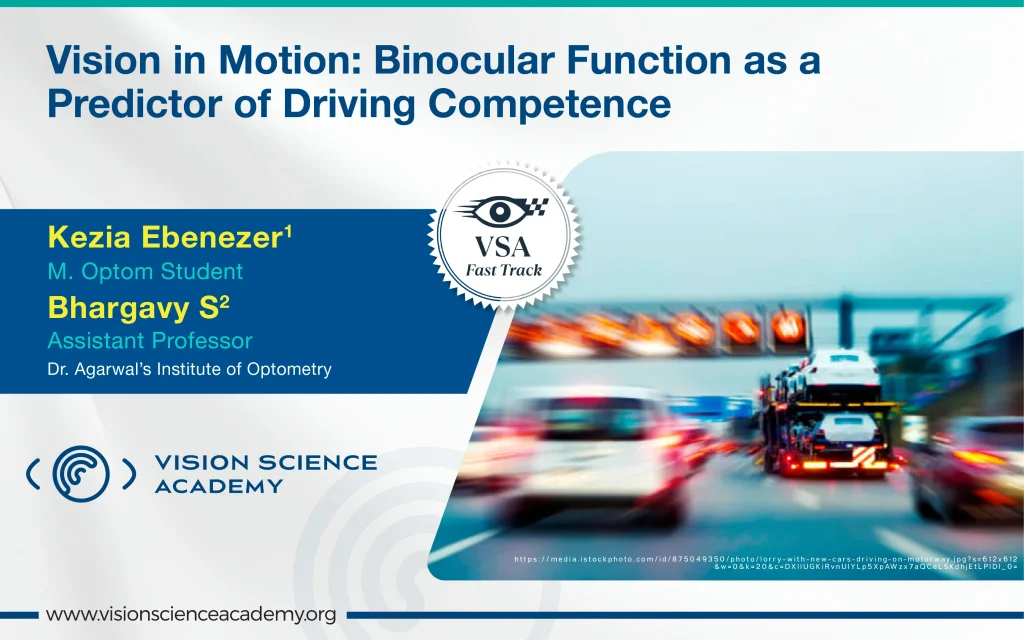Kezia Ebenezer E(1), Bhargavy S(2),
1M.Optom. Student, Dr. Agarwal’s Institute of Optometry, Chennai, India
2Assistant Professor Jr., Dr. Agarwal’s Institute of Optometry, Chennai, India
Driving relies heavily on visual input, with binocular vision being crucial for depth perception, spatial orientation, and motion detection. (1,2)
It enables both eyes to work together to create a unified, three-dimensional view essential for judging distances and reading road signs. (1,2) Impairments such as convergence insufficiency, accommodative issues, or misalignment can delay reaction time and compromise visual judgment, raising accident risk. (2,4)
Hence, binocular vision assessment and intervention should be integral to driver fitness evaluations, especially for aging and commercial drivers. (3)
Binocular Vision Assessment in Drivers
1. Accommodation:
Accommodation allows the eyes to shift focus between distances, a function essential for tasks like reading signs and monitoring the dashboard. Impairments may cause fatigue, blur, and delayed response, especially in poor lighting or at high speeds. (1)
Assessment Tools:
-
- Near Point of Accommodation (NPA)
- Accommodative facility testing
These tests help determine how efficiently a driver can switch focus and maintain clarity.
2. Convergence and Divergence
Convergence (near focus) and divergence (distance viewing) help maintain single vision. Convergence insufficiency can lead to double vision, headaches, and focus issues, affecting driving performance. (4)
Assessment Tools:
-
- Near Point of Convergence (NPC)
- Fusional Vergence Testing
Studies show that individuals with low convergence reserves respond more slowly to peripheral stimuli and struggle with depth perception, which may impact decisions such as overtaking or turning. (2,5)
3. Eye Alignment:
Proper alignment of both eyes ensures accurate binocular fusion and stereopsis. Misalignment conditions like strabismus or phorias can result in diplopia (double vision), suppression, and impaired spatial judgment. (3)
Assessment Tools:
-
- Cover-Uncover Test
- Hirschberg Test
These detect subtle misalignments that may affect driving even without noticeable symptoms. (3,5)
Visual Training and Interventions:
1. Vision Therapy:
Structured vision therapy improves accommodation, vergence, and binocular coordination, especially in cases of convergence insufficiency or accommodative infacility. (4,6) The CITT study confirmed significant symptom relief and better visual performance with therapy. (4)
2. Near–Far Focus Shifting:
This exercise trains the eyes to alternate focus between near and far targets, improving accommodative speed and clarity during tasks like shifting gaze from dashboard to road. (1,2)
3. Brock String Exercise:
Using coloured beads, this tool enhances depth perception and vergence control, important for maneuvers like merging, parking, and turning (5).
4. 3D Vision Therapy and Digital Simulations:
Virtual reality and stereoscopic tasks simulate driving, improving visual processing, convergence-accommodation interaction, and hazard awareness. (6)
Conclusion:
Binocular vision plays a vital role in driving by enabling depth perception, spatial awareness, and quick focus shifts. (2,4,6) Deficits in binocular function can impair distance judgment, slow reaction times, and cause visual discomfort, increasing the risk of accidents. (2,4,6)
Routine binocular vision screening, especially for professional and older drivers, aids in the early detection of visual issues. Targeted vision therapy can address these problems, improving driver performance and reducing fatigue. (4,5) To enhance road safety, licensing and occupational health systems should integrate binocular assessments into standard protocols. (3,6)
References
- Scheiman, M., & Wick, B. (2020). Clinical management of binocular vision: Heterophoric, accommodative, and eye movement disorders (5th ed.). Wolters Kluwer.
- Maples, W. C. (2003). Visual factors that significantly impact driving. Optometry, 74(2), 112–120.
- American Optometric Association. (2021). Optometric clinical practice guideline: Care of the patient with binocular vision disorders. Retrieved from https://www.aoa.org/
- Convergence Insufficiency Treatment Trial Study Group. (2008). Randomized clinical trial of treatments for symptomatic convergence insufficiency in children. Ophthalmology, 115(3), 582–589. https://doi.org/10.1016/j.ophtha.2007.10.011
- Griffin, J. R., & Grisham, J. D. (2012). Binocular anomalies: Diagnosis and vision therapy (5th ed.). Butterworth-Heinemann.
- Cooper, J., & Jamal, N. (2012). Use of vision therapy to improve driving safety. Journal of Behavioral Optometry, 23(2), 31–37.
